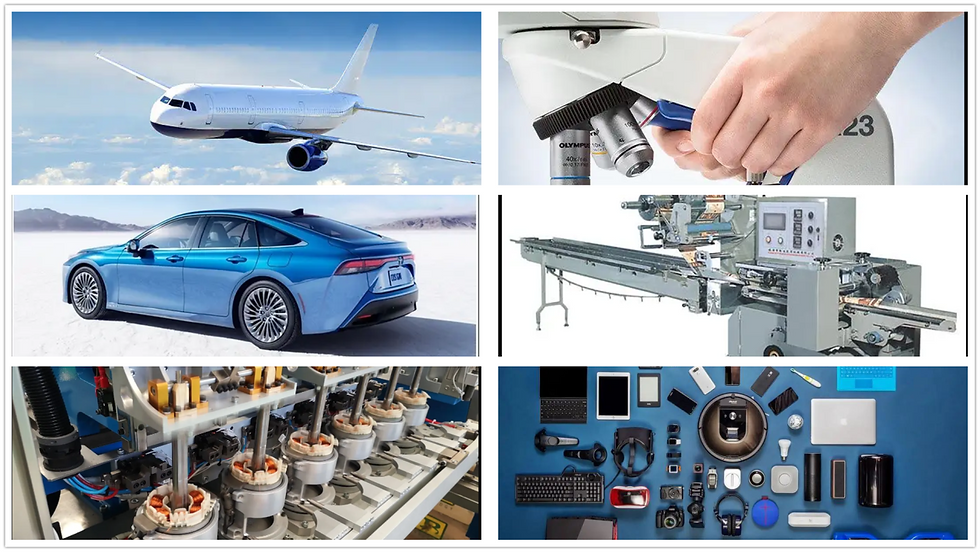CNC Machining: The Ultimate Guide to Precision Manufacturing
- Bhargava Krishna Marripati

- Jul 23
- 5 min read
Updated: Jul 24
Introduction to CNC Machining
What is CNC Machining?
CNC (Computer Numerical Control) Machining is a subtractive manufacturing process that uses computer-controlled tools to shape materials into precise components. Whether you're crafting an airplane wing, a smartphone casing, or a prosthetic limb, CNC machining ensures extreme accuracy, speed, and repeatability.

Table of Contents
A Brief History of CNC Technology
CNC technology traces back to the 1940s when punched tape-controlled machines were first developed. By the 1970s, digital computers took over, and CNC machines began revolutionizing how manufacturers built complex components. Today, CNC machining is the backbone of precision manufacturing.
How CNC Machining Works
The Basic Workflow
Think of it as baking, but with metal and extreme precision. Here's the typical CNC process:
Design the part in CAD software.
Convert the design into G-code via CAM software.
Load the G-code into the CNC machine.
Machine the part by cutting, drilling, or milling the raw material.
Inspect the final piece for quality control.
Key Components of CNC Machines
Controller

The brain of the operation. It interprets G-code and directs the machine’s movements.
Machine Tool

The part that performs the action—cutting, drilling, etc. Common tools include mills, lathes, and drills.
Feedback Systems
These sensors monitor the machine’s position and movements to ensure precision and accuracy.
Types of CNC Machines
CNC Milling Machines

These machines rotate cutting tools and move the workpiece to remove material. Ideal for complex 3D shapes.
CNC Lathes

Perfect for cylindrical parts. The workpiece spins while the tool shapes it.
CNC Routers

Typically used on softer materials like wood, plastic, and aluminum. Think of them as high-speed carving machines.
CNC Plasma Cutters

These cut through metals using a high-powered plasma torch. Great for sheet metal fabrication.
CNC EDM Machines

EDM stands for Electrical Discharge Machining. It’s like sculpting with electricity—used for hard metals and delicate features.
CNC Machining Processes
Milling

Milling machines remove material using rotating multi-point cutting tools. Used for slots, holes, and complex shapes.
Turning

Turning involves spinning the part and cutting along its axis. Ideal for symmetrical shapes like shafts and pins.
Drilling

As simple as it sounds—creating holes with high precision and consistency.
Grinding

Used to achieve high surface finish and tight tolerances by removing small amounts of material.
CNC Programming and G-code
What is G-code?
G-code is the machine language that tells CNC machines where to move, how fast, and what path to follow. It's the roadmap for the whole operation.
CAD and CAM Software

You start with CAD (Computer-Aided Design) to design the part. Then, CAM (Computer-Aided Manufacturing) turns that design into G-code instructions.
Popular software includes:
Fusion 360
SolidWorks
Master cam
AutoCAD
Materials Used in CNC Machining

Metals
Aluminum
Steel
Titanium
Brass
Plastics
ABS
Nylon
PEEK
Polycarbonate
Composites
Carbon fiber-reinforced plastics
Fiberglass
Applications of CNC Machining
Aerospace

Precision and performance—CNC machining delivers parts that meet tight tolerances and high safety standards.
Automotive
From engine blocks to custom exhaust tips, CNC plays a huge role in the car industry.
Medical Devices
Prosthetics, surgical instruments, and implants—reliability is key.
Consumer Electronics
Casings, buttons, heat sinks—everything you touch in a smartphone likely started on a CNC machine.
Advantages of CNC Machining
Precision and Accuracy
Tolerances as tight as ±0.001 mm are achievable—ideal for mission-critical parts.
Repeatability
You can make 10 or 10,000 identical parts with the same quality.
Speed and Efficiency
CNC machines run 24/7 with minimal supervision.
Limitations of CNC Machining
Initial Cost
High setup and machinery costs can be a barrier for small operations.
Complexity in Setup
Programming and fixture setup need skilled technicians.
Material Waste
As a subtractive method, material wastage is more than additive manufacturing.
CNC Machining vs. 3D Printing
Key Differences
Feature | CNC Machining | 3D Printing |
Material | Mostly metals | Mostly plastics |
Speed | Faster for bulk | Slower per part |
Precision | Higher | Lower (in most cases) |
When to Choose One Over the Other
Choose CNC for structural, high-precision, or load-bearing parts. Go with 3D printing for prototypes, complex geometries, or low-volume runs.
Future Trends in CNC Machining
Automation and AI Integration
Smart CNC machines now adapt in real-time, correct tool paths, and predict failures.
Industry 4.0 and Smart Factories
Connected machines sharing data to optimize operations—CNC is at the heart of this evolution.
Cost Considerations
Cost of Machines
Anywhere from ₹5 lakhs to ₹2 crores depending on size and complexity.
Cost of Operation and Maintenance
Energy, tooling, software, and skilled labor all add up—be ready to budget accordingly.
Choosing the Right CNC Machine
Based on Material and Application
Different tools work better for aluminum than for hardened steel. Know your material before choosing your setup.
Based on Production Volume
Small batch = basic 3-axis. Mass production = multi-axis with auto-loading.
Tips for Getting Started with CNC Machining
Training and Certifications
Look for courses in CAD/CAM software, G-code programming, and machine operation.
Recommended Tools and Resources
YouTube channels: NYC CNC, Titans of CNC
Books: “CNC Programming Handbook” by Peter Smid
Forums: Practical Machinist, Reddit’s r/CNC
Conclusion
CNC machining isn’t just about cutting metal—it’s about precision, innovation, and scaling manufacturing to a whole new level. Whether you're launching a startup or upgrading your production line, CNC is the powerhouse that can make it happen.
FAQs
1. What does CNC stand for?
CNC stands for Computer Numerical Control—machines guided by computers to manufacture precision parts.
2. Is CNC machining better than manual machining?
Absolutely. It's faster, more accurate, and can handle complex geometries with consistency.
3. How expensive is a CNC machine?
They can range from ₹5 lakhs for basic desktop units to ₹2 crores for industrial 5-axis models.
4. What industries use CNC the most?
Aerospace, automotive, medical devices, and consumer electronics are top industries relying on CNC.
5. Can I learn CNC machining online?
Yes! Platforms like Coursera, Udemy, and YouTube offer comprehensive beginner-to-advanced CNC courses.





Comments